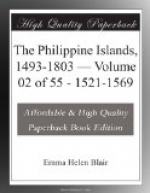boarded the junk, and found it laden with porcelain,
cloths, figured linens, and other products of their
country, together with some beads of hammered gold.
Of these latter they took but one, with some of the
porcelain and cloth—a little of each thing—to
carry as specimens. In going and returning this
patache consumed two hundred and thirty days.
They were compelled to run to the north, beyond the
fortieth degree. From the port of departure to
that island, they sailed one thousand seven hundred
leagues. ¶Within fifty days, the other three vessels
discovered many islands. They anchored at some
of these, and in each one they suffered many hardships.
So long is the relation of this, that it fills twenty
sheets of paper. [106] Finally they landed at a large
island named Iubu, where they made friendship with
its king. This was done in the following manner.
The king drew some blood from his breast, and the
captain did the same. The blood of both was placed
in one cup of wine, which was then divided into two
equal parts, whereupon each one drank one half; and
this, they assert, constitutes inviolable friendship.
Notwithstanding this, they had certain conflicts,
and sacked a little village. In a poorly-built
house was found an image of the child Jesus, such
as comes from Flanders, with his veil and the globe
in his hand, and in as good condition as if just made.
They wished to settle in that island, because of the
abundance of all kinds of food. They began the
construction of a fort, outside of which they erected
a church, wherein the child Jesus was placed, and
they called the church Nombre de Jesus ["Name
of Jesus"]. They named the island Sant Miguel,
because of landing there on the day of his apparition.
From here to the Malucos, where the spice is found,
there is a distance of one hundred and twenty leagues;
to China, two hundred; and to Malach [Malacca], five
hundred. They found in this island the finest
cinnamon, which its people acquire through trade with
the Malucos; besides ginger and articles of fine silk.
Of the three vessels, the flagship was despatched
from that island to Mexico, where it arrived later
than the patache, and where two other vessels
were being prepared as a relief. There are many
other very large islands in that region, in appearance
quite like the above-named island. Among others
is a region so rich in gold, that the amount is beyond
estimation. And there is so great abundance of
cinnamon that it is burned instead of wood by those
people, who are as luxurious as those of Spain.
They have a king there who has a constant body-guard
of one thousand men, and who is esteemed so highly
that none of his subjects see his face oftener than
once a year. If they find it necessary to converse
with him on any matter, they speak to him through
a long wooden tube. And when he annually permits
himself to be gazed upon, his subjects give him many
valuable things. These people are quite advanced.




